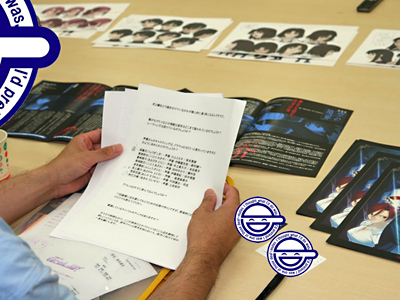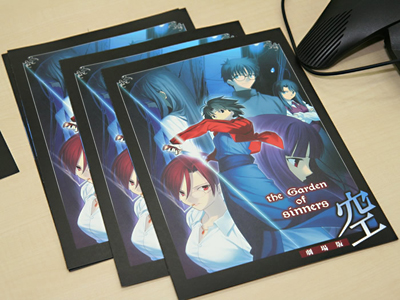Interview with Kinoko Nasu Concerning the Theatrical Version of Kara no Kyoukai
Originally appeared on ComiPress
Part 1 | Part 2
Translation by Sarah Neufeld
As Kara no Kyoukai is being fully animated for the big screen, Karzu, an impassioned fan of Kinoko Nasu, got to talk to him about this and that. The 2-part interview was published on Akiba Blog in September 2007. Below is the English version of Part 1 and Part 2 of the interview:
Master Kinoko Nasu is the scenario writer for TYPE-MOON, which made the "moe" business world globally famous through its games Tsukihime and Fate/stay night. Kara no Kyoukai is a long adventure novel penned by Master Kinoko in his early days. He began releasing it on the Web in 1998, and, three years later, he self-published it. In 2004, after being corrected and retouched by Kodansha, it was republished in a commercial edition as Kara no Kyoukai - First Half and Kara no Kyoukai - Second Half, becoming a big hit.
Now, Kara no Kyoukai has been fully animated for the big screen (official site). As a result, Master Kinoko Nasu's impassioned fan, Karzu, got to talk to him about several things!
The Road to the Theatrical Edition of Kara no Kyoukai
First of all, could you tell me what exactly happened to get this work into the theaters?
Kinoko Nasu: Certain people have been wanting to make Kara no Kyoukai into an anime for a while now, but it isn't a story which really lends itself to being filmed, so I always turned them down. I thought, since the story is like a prose poem, if it ran as a TV anime, the audience's consciousness would feel scattered; it would be hard to understand, and would probably stress them out. When they said, "Well then, what about a movie?" I thought, "Huh! I see. Before the movie begins, there's the physical activity of actually getting to the theater, so the audience's power of concentration might be heightened..." And just as I was about to let myself be persuaded by that, I thought about it calmly and realized that it would still be hard after all (laughs). I calmed down, and the discussion ended there.
After that, I thought there'd probably never be a Kara no Kyoukai anime, but one year ago, I heard from Kodansha's Oota-san. (Oota Katsushi from Kodansha. As an editor, he started the literary magazine Faust, and is presently the editor-in-chief of the new start-up label, Kodansha BOX. This label also has Nasu-san's latest work, DDD.) Oota-san's offer was: "I was thinking of teaming up with Aniplex and ufotable and making Kara no Kyoukai into a consecutive seven-movie release; what do you think?" It was such an off-the-wall idea that I got caught up in the enthusiasm; the offer was so awesome that turning it down seemed rude, so I agreed readily.
Of TYPE-MOON's works, Shingetsutan Tsukihime (hereafter Tsukihime) and Fate/stay night (hereafter Fate) have been animated, so I didn't think a theatrical version alone would really make the users all that happy at this late date. But a consecutive seven-movie release – that's incredibly exciting both for the viewers and for the production side, so it seemed like it might be worth doing.
That's a pretty revolutionary plan, isn't it? Seven movies in a row...
Nasu: One could also call it "reckless" (laughs).
And it isn't embarrassing to have one of your older works dug up?
Nasu: Of course it is, yes. Kara no Kyoukai was something I wrote when I was at my most inexperienced; now that, after ten years, it's risen from the grave like this -well, it's not exactly "The Monkey's Paw" (*1), but there's still sort of an "I should've stopped it" feeling. You've got to understand, though, that's only as far as the original book goes; when I see the finished PVs and how much energy the staff is putting into this, it isn't Kara no Kyoukai, but Theatrical Edition: Kara no Kyoukai that I feel I'll really be able to be proud of.
Did you ever think of using this animated version as an opportunity to take the parts of the original novel which you always thought you would have liked to fix and improving those, altering the original elements?
Nasu: In Kara no Kyoukai, the first story, "Overlooking View" (俯瞰風景) is the clumsiest. I've always thought I wanted to do something about it, and I told a staff member, "If we're making this into a movie, I'm going to rewrite the first story; please let me do that." But he said, enthusiastically, "No, I want to work with it the way it is. I want to animate this!"
Then, when I read the finished script, they'd cut out over half of the unnecessary excess fat and had turned out something more interesting as a story, so I thought, "If it's like this, they don't need me to rewrite it."
The elaborate setting of Kara no Kyoukai is one of its distinguishing characteristics; there's a fear that, even if it's filmed as-is, there won't be enough explanation. How are they resolving that?
Nasu: By cutting out the bits that get in the way. Then by expressing what they can through the pictures, the beautiful background art and the atmosphere of the film, and keeping in words only the devices that absolutely have to be there. However, I think there are still places left which you won't understand after just one viewing. You can probably understand those better by watching it through again, or by reading the book.
How well do you think people first coming into contact with Kara no Kyoukai will follow it?
Nasu: It may not be possible after just the first story. We're doing it in its original chronological order, so even if the first and second stories are well made, they'll only have a superficial understanding of the whole story through them; when they've watched all seven stories through, I think they'll finally be at the point where they can understand it without reading the original.
There have been all sorts of discussion about ways to get people to come to the theater seven times. (*2) Could you tell me anything - just a hint - about what those methods might be?
Nasu: There are a lot of ideas out there, but they're still under consideration. The most outrageously starry-eyed ones have been vetoed. Insane ideas such as, for the first story, having the entire first novel run in pamphlets with, not just the cover, but all the pages covered in silver lamé, at a cost of 3,000 yen (laughs). (*3)
(Laughs) But that method - it wouldn't simply be to leave things hanging at the end or something similar, would it?
Nasu: Of course we're thinking that, too, but each story is basically complete unto itself, so... We want the viewers to feel refreshed at the conclusion part of the "introduction, development, turn and conclusion" bit (*4), leave a little left hanging at the end via production, and finally, we'd like to have them leave the theater feeling glad they came.
When you say it's the same as the original work... The order in the original is all over the place, chronologically. I believe there was a plan at one point to rearrange the order and restructure it to make it more easily understandable...
Nasu: As I said a little while ago, the staff said that they wanted to work with the original novel as-is, that they ultimately wanted the focal point to be on producing that feeling of untraceable bewilderment and the sensation of an imbalance that's become its own entity, so it was decided to release the work in its original order. If these were going to be coming out one every six months, I would absolutely have stopped them, but fortunately, they're slated to be put out one every month for about seven months, so I think we'll probably be able to get by with having the story all over the place. I think this is something we can do only because there's not much time between releases.
About those seven releases - the lengths of each of the chapters vary pretty widely; will the movies all be roughly the same length?
Nasu: They won't, no. If it were a TV anime, the episodes would have a set length of twenty minutes each; however - and this is one of the best things about a theatrical release - the lengths of the movies are varied.
Personally, I'm really curious as to how they're going to visually differentiate between Shiki (式) and Shiki (織) ...
Nasu: The cute, moe-type character is the boy Shiki (織), and the prickly-seeming one is the girl Shiki (式). The cuteness of the boy Shiki in the second chapter is absolutely incredible (laughs).
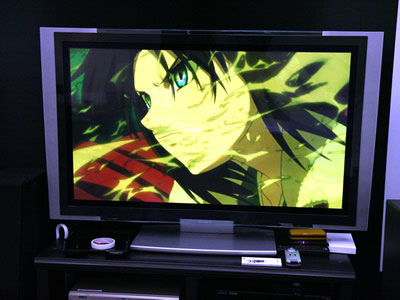
Oh, this is great!
Nasu: I don't think anyone will be able to complain about the quality.
I caught a glimpse of it here in the PV, but how much detail have the more brutal images (such as arms being torn off) been drawn in? Has it been rated?
Atsuhiro Iwagami (Aniplex producer): We're trying to keep things as close as possible to the original. The rating itself is entirely up to EIRIN's (*5) decision, but (the images) are pretty much in shadow, so it'll be fine.
Nasu: Um, no, it looked very realistic in the PV just now. (Laughs)
At the Comike venue, when that brutal part of the PV showed up, there weren't any cries of outrage or denial?
Nasu: It was absolutely fine. And the next venue over was playing moe songs... (Laughs)
(Laughs) This will be (TYPE-MOON's) third animation, after Tsukihime and Fate; is it coming as an extension of those previous two, or has it followed a different visual path?
Nasu: Tsukihime and Fate, both being based on games, already had visuals, so there was the double hurdle of preserving the game's visuals while having to transform it into an anime. You try to live up to the hopes of the original's fans and to recreate the scenes from the game, but since those scenes were unmoving pictures, you also have to bring them to life; making those two angles compatible is hard.
On the other hand, Kara no Kyoukai is being drawn from scratch. Since there aren't any visuals that the animators have to stick to, they have more freedom where that's concerned, but there are "labor pains" involved in making something from nothing. Both types of hurdles are high ones, but I think the one involved in drawing Kara no Kyoukai will, due to its unique characteristics, bring a fresher surprise to the viewers when they watch it.
The director, the staff, and you, Nasu-san, all have different ideas of what things should look like in your minds. Do those differences ever come up?
Nasu: I think it's inevitable that those come up, in any project. It's just, even if our ideas differ, I personally have no talent for drawing, so it only ever gets to the level where they'll show me a picture and I'll say either, "Yeah, go for it!" or, "Do you think you could bring out this sort of atmosphere a little more here?".
Then, to begin with, the art boards (*6) for Kara no Kyoukai always surpassed my imaginings, so there was nowhere for me to inject my opinion. Because of that, I almost want to tell the people who'll decide to read the original book after seeing the movie, "Don't read it!" (Laughs)
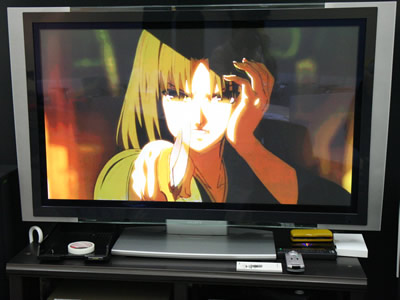
How the Casting of Voice Actors for Kara no Kyoukai was Decided
The cast of voice actors has changed quite a lot from what it was on the drama CD; how were they chosen?
Nasu: The four companies - ufotable, Aniplex, Kodansha and TYPE-MOON - decided the auditions by vote. However, fundamentally, ufotable is producing the anime; they said "We'd like to make this sort of film, so we're looking for this sort of voice", and we made that top priority. Meaning that our opinions were really used only when ufotable's internal opinion was split; they were then taken into consideration to aid in the decision. "This is a theatrical release, and the voice will be played into a huge closed room, so it would be better to have a voice that's a little 'chic'-sounding", or "It would be better to have a lower voice here", etc. - We took concepts like those as our starting point, and narrowed the choices down from there.
Nasu-san, was there anyone besides Nakata Jouji-san that you absolutely wouldn't give up? (Laughs)
Nasu: No, no (Laughs). I thought, if we were changing one actor, we might as well change then all, but ufotable thought Nakada-san was best, no matter what. They said things like, "Jouji is best for Araya. Araya is best for Jouji." (All laugh.)
As far as Sakamoto Maaya-san for Ryougi Shiki was concerned... At the audition stage, we had quite a strong image of Shiki, and I thought I'd like them to decide on Sakamoto-san.
I liked Kawakami Tomoko's Shiki on the drama CD, too, though.
Nasu: Oh, I loved Kawakami's Shiki! After the new cast was publicized, I got protest e-mails from acquaintances (Laughs). Kawamoto Tomoko-san's Shiki was an "upper" type, a rather energetic Shiki. Sakamoto Maaya-san's Shiki is a "downer" type. In order to suit the heavy atmosphere of this "Theatrical edition: Kara no Kyoukai", we chose to have Sakamoto-san act for us this time.
I thought the choice of Suzumura Kenichi for Kokutou Mikiya was pretty unexpected.
Nasu: Suzumura-san delivers a good voice. The young voice I heard at the audition had no irony in it, and it sounded main character-ish, even so: I thought, "This is the image for Mikiya."
Why was Honda Takako-san chosen to play Aozaki Touko?
Nasu: First of all, she has a powerful voice, but she still sounds very feminine. Plus, since her character talks for the longest period of time of anyone in this story, we thought it would be best to have a voice that people wouldn't get tired of, no matter how long they listened to it. Then, we also needed someone who could make the scary voice for the times when she takes off her glasses...
And Fujimura Ayumi-san plays the role of Kokutou Azaka? I believe this was the hardest character to cast...
Nasu: Right; we had to choose between making her incredibly bright and cute, or modulating her character to fit the chic theatrical atmosphere, and we went for the latter.
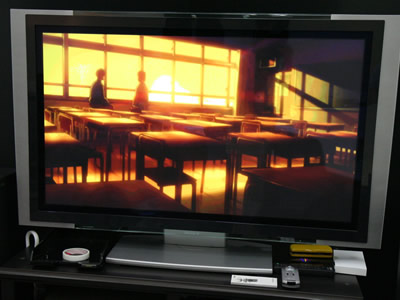
By the way, Nasu-san, who is the most moe-type character here as far as you're concerned?
Nasu: To me, Asagami Fujino is the most straight-forwardly moe character. I love angst-filled characters; now that I think about it, maybe that's the only kind of character I've written... Well, but looking at the moving pictures, Ryougi Shiki's taken first place. Her "downer" voice, too: since I like angsty heroines, I just can't get enough of it. (Laughs)
Also by the way, are you aware of any rival anime movies?
Nasu: If I were to say this prettily, the rival would probably be the immediately previous Theatrical Edition: Kara no Kyoukai. They each have different directors, so while the story is continuous, the visual works themselves will be different.
Come to think of it, you wrote quite heatedly in your own journal (Chikusou Nikki) about the new Evangelion theatrical release.
Nasu: I'm feeling a bit apologetic about that myself (Laughs). However, any work that can deal out an impact like that is a treasure; if you're grateful, the least you can do in return is call a delicious thing "delicious" and thank them. All I can do now is pray that the release times don't clash. But I do want it to be released quickly, tomorrow if possible! As a fan, I couldn't be happier about the new Evangelion movie. For me, a rank-and-file soldier, seeing that the king is still as invincible as ever makes me incredibly happy.
In conclusion, could you say a word both to the fans of the original work and to people who aren't familiar with it, telling them what you'd like them to look out for?
Nasu: I'd like fans of the original work to really feel to their bones the surprise that they'll get when they see things -- things which were, until now, taken care of solely in the text -- transformed into visuals. For example, Shiki is a character who includes quite a lot of lies. Kimonos are such that you can't really spread your legs, so she couldn't really do actions scenes wearing what she does. When "lies" like that are transformed into visuals, how far can they follow the original while simultaneously creating something beautiful?
For example, even in the PV we just saw, she flies quite properly, with her legs together. I'd like them to look out for places like that. To those who haven't yet read it, first of all, I'd like them to feel charmed by Shiki's behavior; she's a heroine who has some very courageous, masculine places, and also some very girlish ones. I think it would be good if they could then use that as a foothold and really enter into the story.
Thank you very much for your time.
*Nasu-san knew of Karzu SP beforehand, and when he told Karzu, "I've read all of 'Yandere Dai' (*7), Karzu (as one who had written a "The Yandere heroines who appear in Kinoko Nasu's works" corner), felt quite unbalanced... How did you feel about this extremely dense, heavy interview?
Theatrical version Kara no Kyoukai Chapter 1 will be released on 12/01/07, Chapter 2 will follow on 12/29/07, and Chapter 3 is scheduled to begin showing on 01/26/08.
Theatrical version Kara no Kyoukai
Chikusou
TYPE-MOON
Footnotes
*1: The Monkey's Paw: At one point in this story, an older couple wishes that their dead son was alive again, then - when, presumably, his zombie shows up - must wish him back in his grave. See Wikipedia article for details.
*2: In Japan, regular movie tickets run about $18 each.
*3: Roughly US $30.
*4: Classic rules for composing a Chinese poem, which have since taken on a general meaning of summarizing the basics of good storytelling.
*5: EIRIN = The Administrative Commission for the Motion Picture Code of Ethics.
*6: Art board - Graphic reference materials drawn by the art director to keep the director and staff on track about the direction the art is supposed to take. (Rather like an instruction manual.)
*7: Yandere – Defined as a type of character who starts out by acting sweet and loving, but gets very violent when events turn against her (usually) or him.





